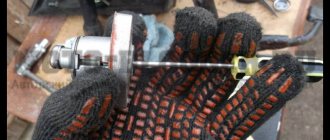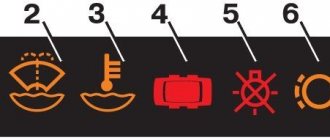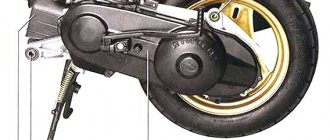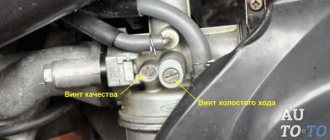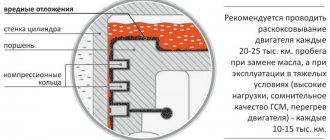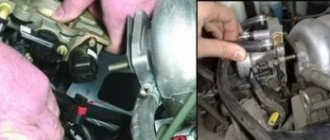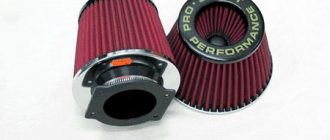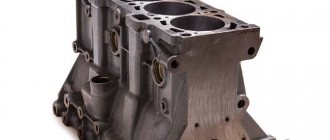OKA with engine from 2108
write who saw and heard. there is a motor but somehow it’s impossible to push it in
Looks like they're pushing it into the back seats instead
The factories are standing still, there are only bloggers around...
although there are also such photos
The factories are standing still, there are only bloggers around...
Posted by
evgen073write who saw and heard. there is a motor but somehow it’s impossible to push it in
why do you need it?
however, it makes a race... but the faster you go in such a car with a small weight... the easier it is to turn it over with a side wind... Be careful with the vehicle
Message from
Failurehowever, it makes a race... but the faster you go in such a car with a small weight... the easier it is to turn it over with a side wind... Be careful with the vehicle
a heavy engine will change the weight distribution and worsen road behavior. There is zero security in sight. you need to start with the brakes first
as always, there are tons of answers “ON THE TOPIC,” and I’ve seen this and other photos more than once.
Posted by
evgen073as always, there are tons of answers “ON THE TOPIC,” and I’ve seen this and other photos more than once.
You don’t need that engine in there. That’s the whole answer. It does more harm than good.
replace the rear seats with a transfer case and all-wheel drive
The factories are standing still, there are only bloggers around...
By the way, I saw somewhere that they installed a Yamaha engine in the Oka or Matiz, there are more mares there than in the eight-wheeler. The moment I really think is smaller
The factories are standing still, there are only bloggers around...
Message from
HypnocatBy the way, I saw somewhere that they installed a Yamaha engine in the Oka or Matiz, there are more mares there than in the eight-wheeler. The moment I really think is smaller
Oka this)) The torque on the wheels can be increased by the gear ratio in the transmission. In terms of speed, motorcycle engines allow this.
VAZ-2114 1.6 16V 98Hp 2010 Skoda Rapid FL 1.6 115Hp (cwvb + chip) 2021
Only a bicycle can have two pedals. UAZ Patriot - the nature of movement. But the Audi A6 is different.
Yesterday I tried it on the stretcher, it fits very well. I just need to move the crankshafts of the pillows, but the gearbox switch is getting in the way of installing the rack.
well, yes .. the video is cool ... put the vehicle hubs on 13th wheels. There will be more brakes and more grip on the road
The wheels have been 13 for a long time, I push any turn at 80
Posted by
Nemez00a heavy engine will change the weight distribution and worsen road behavior. There is zero security in sight. you need to start with the brakes first
Do you sell parachutes?
Message from
HypnocatBy the way, I saw somewhere that a Yamaha engine was inserted into an eye or a Matiz
I think it's a film montage. They superimposed the interior of the Oka onto the video of the motorcyclist.
Googled it. No. Indeed there is. https://www.youtube.com/watch?v=-03jf..._order&list=UL It let me down that Oka can’t slow down like that. And she has new disc wheels on all wheels. ))) 180 goes. On Oka and 120 it’s scary. )))
Last edited by persey4ik; 11/01/2013 at 20:19.
Related topics
- Replies: 12
Last message: 08/09/2012, 18:39 - Answers: 14
Last message: 01/20/2011, 08:23
- Answers: 25
Last message: 10/13/2010, 11:35
- Replies: 52
Last message: 05.11.2008, 10:46
- Replies: 69
Last message: 07/09/2007, 04:12
Current time: 04:20. Time zone GMT +3.
Oka with a VAZ 2108 engine
The hopelessness that accompanied the Soviet automobile industry throughout the entire period of its existence was permanent. Still, it was not completely eradicated, and it timidly stepped into the 21st century along with new domestic developments. Although there remain some examples of cars from the country of the Soviets dear to the heart of the nostalgic automotive esthete.
Content:
Oka 1111, as it is
Oka 1111 is one of these examples. A nice, progressive in its time, but little promoted project. Half-eight engine, 33 horsepower, moderately stiff chassis, excellent, almost BMW-like handling and maneuverability. This is how we can briefly describe Oka as it is. The car has its fans, and there are many of them. This can be explained very simply - this is the cheapest minicar on the market. Cheaper than a Korean scooter. Seven years ago, in 2007, they asked for less than $4,000 for a new Oka.
For the money, the car worked perfectly, and with an average consumption of 5 l/100 km, it satisfied the needs of not too capricious motorists. This is the quintessence of minimalism, the most simplified design of the suspension and chassis, and there’s no need to talk about the interior. He looks frankly poor even if measured by the standards of the 1980s.
The car was produced at three factories at once. The most trump card Oka came out of the gates of AvtoVAZ, some of the cars were produced by KamAZ, and the main load lay on the Serpukhov Automobile Plant, which before Oka produced wheelchairs. In 2005, Naberezhnye Chelny stopped producing Oka due to unprofitability, and instead began the assembly of Korean SsanYoung. VAZ had enough problems without the Oka, but in Serpukhov they decided to continue producing the minicar, but more on that a little later.
Oka with a VAZ 2108 engine
No, no one thought of mass-producing the Oka with a V-8 engine. The public is very often concerned with the question of how to increase the power of a minicar and put something more high-torque on it. Apparently, craftsmen can’t find anything better than the VAZ 2108 engine. Amazing stubbornness, but that’s not what we’re talking about now.
Indeed, it is possible to install a power unit from a V8, together with a gearbox from 2110, into the body of an Oka, and moreover, history knows such cases. Another thing is what this will give the owner after a complete rework of the car’s chassis, purchase of another engine, installation, adjustment and fine-tuning. Increase in power? It was 33, now it's 70. Well, it's a worthy replacement, considering the amount of work that had to be done when installing the motor. And the list is not weak:
- dismantling the original engine and gearbox;
- dismantling the front suspension;
- changing the shape of the engine compartment;
- making a new subframe;
- installation of VAZ 2108 front suspension;
- fine-tuning and tuning of the front suspension to strengthen and increase rigidity;
- installation of gearbox 2110;
- installation of steering 2108.
At the same time, it is necessary to maintain the geometry of the steering and suspension, otherwise the struts, supports, front hub bearings, drive shafts and CV joints will work inconsistently and not according to the design characteristics. For example, the front strut of an Oka with a VAZ 2108 engine, the photo of which we placed in this material, has a difference in inclination angle with the calculated one, which directly affects the distribution of the load across the shock absorber and supports.
Despite all the blatant violations of geometry, the car has undergone more than 30 thousand after tuning, and according to the owner, everything works properly. There are many such aspects; we have given the stand just as an example.
Oka 1111 and its potential
If we abstract from everything that the global automotive industry offers and leave only Oka, then it really has good potential. In the photo in this section you can see how they made an excellent crossover out of the Oka, taking advantage of the winning aspects of the body.
The main advantage of the Oka is its excellent body, which allows it to be used on light off-road conditions, and the owner of this car accurately identified the positive aspects of the design:
- fairly high rigidity with good volume;
- minimal overhangs front and rear;
- small mass.
The complete package to become a small front-wheel drive crossover. The owner decided to do something more practical and logical with the engine. Do not rely on the obsolete eight-cylinder engine with its weak power supply, but use a three-cylinder engine from Rover with a power of 63 horsepower and a volume of 1.3 liters.
The size of the engine fits optimally under the hood along with the gearbox, and all suspension and brake parts were replaced with figure-eight ones. No vandalism, sober calculation and maximum efficient use of Oka's potential. The car looks very convincing in appearance and does not smell of handicraft.
Factory response to global tuning
Meanwhile, while enthusiasts were heating up gas burners and welding subframes, the Serpukhov Automobile Plant prepared a surprise, and in 2006 released Oka with an engine from the Chinese FAW car. The engine was three-cylinder, had a liter of volume and 53 horsepower. Naturally, the car has become faster, more economical, more maneuverable, and a thousand dollars more expensive.
Now its price was approaching the price of the VAZ 2107, demand for the car was naturally falling, the plant was selling off its warehouse balances and curtailing production. We won't see the new Oka again.
There were several more attempts to revive the domestic minicar, but this is also a long and sad story.
If you are lucky enough to have a nimble Oka, take care of it and tune it with respect. Don’t offend the little ones on the road, and have a safe journey!
Source
Modernization of the VAZ-11113 “Oka” engine
Oka with a VAZ 2108 engine
No, no one thought of mass-producing the Oka with a V-8 engine. The public is very often concerned with the question of how to increase the power of a minicar and put something more high-torque on it. Apparently, craftsmen can’t find anything better than the VAZ 2108 engine. Amazing stubbornness, but that’s not what we’re talking about now.
Indeed, it is possible to install a power unit from a V8, together with a gearbox from 2110, into the body of an Oka, and moreover, history knows such cases.
Another thing is what this will give the owner after a complete rework of the car’s chassis, purchase of another engine, installation, adjustment and fine-tuning. Increase in power? It was 33, now it's 70.
Well, it's a worthy replacement considering the amount of work that had to be done when installing the motor. And the list is not weak:
Despite all the blatant violations of geometry, the car has undergone more than 30 thousand after tuning, and according to the owner, everything works properly. There are many such aspects; we have given the stand just as an example.
Oka with VAZ-21083 engine - personal experience
Factory response to global tuning
Meanwhile, while enthusiasts were heating up gas burners and welding subframes, the Serpukhov Automobile Plant prepared a surprise, and in 2006 released Oka with an engine from the Chinese FAW car. The engine was three-cylinder, had a liter of volume and 53 horsepower. Naturally, the car has become faster, more economical, more maneuverable, and a thousand dollars more expensive.
Now its price was approaching the price of the VAZ 2107, demand for the car was naturally falling, the plant was selling off its warehouse balances and curtailing production. We won't see the new Oka again.
Installing a VAZ 2108 engine on the Oka
Vehicle characteristics: The dimensions of the car are as follows: length - 3427, width - 1100, height - 1053 mm. The wheelbase is 2284 mm. Ground clearance 187 mm. The car is equipped with a hybrid power unit.
The 2-cylinder engine is equipped with a system that provides engine power output. There are 4 valves per cylinder. The diameter of one cylinder is 71 mm, the piston stroke is 78 mm. The engine crankshaft accelerates to 2000 rpm.
Maximum torque is maintained up to 3000 rpm.
How to install a VAZ 2108 engine in an eye
Reasoning from a car owner named Anatoly: + As it was used, it had to be serviced in different cities - these are Rostov-on-Don, Tver, Voronezh, Moscow, Vladimir. In all these cities there were no queues, no time delays, no repair problems.
+ I took the car without a built-in display and in the existing compartment for storing keys it is very convenient to put an iPhone with maps :) + I glued sticky tape to the dashboard and installed a radar detector on it - a lot of space. + Vehicle. I wanted to go to the forest, I wanted to go to the river, I wanted to and went.
+ The stabilization system works well.
Vehicle characteristics: The vehicle dimensions are as follows: body length - 3369, width - 1100, height - 1852 mm. The wheelbase is 2407 mm. Ground clearance 214 mm. The car is equipped with a hybrid power unit.
The 2-cylinder engine is equipped with a system that provides engine power output. There are 4 valves per cylinder. The diameter of one cylinder is 73 mm, the piston stroke is 75 mm. The engine crankshaft accelerates to 6000 rpm.
Installing a VAZ 2108 engine on the Oka
Category: Auto repair
Vehicle characteristics: The dimensions of the car are as follows: length - 3427, width - 1100, height - 1053 mm. The wheelbase is 2284 mm. Ground clearance 187 mm. The car is equipped with a hybrid power unit. The 2-cylinder engine is equipped with a system that provides engine power output. There are 4 valves per cylinder. The diameter of one cylinder is 71 mm, the piston stroke is 78 mm. The engine crankshaft accelerates to 2000 rpm. Maximum torque is maintained up to 3000 rpm.
Posted by admin: at the request of Etienne
Views: 2284
Watch the VIDEO about installing a VAZ 2108 engine on the oka.
Review from a car owner named Gennady: Car: spacious, very soft ride even on bad roads at high speed, excellent dynamics especially on mountain roads, ESP traction control system works great, cross-country ability like an SUV taking into account the low ground clearance, excellent stability and controllability, very efficient climate control (cools the interior in a couple of minutes after parking in the heat), accelerates to 235 km/h. When towing a trailer, there is almost no difference in dynamics.
Original name: ?? ?? VAZ2108? Oka
Release date: 05/06/2021
Duration: 6:58
Quality: TVRip
Laughter in the topic: Medical Institute, Faculty of Gynecology. Professor to first-year students: - Everyone should have a favorite girl. You won't be able to do your homework without this.
Video instructions: installing a VAZ 2108 engine on the Oka
Tuning VAZ → Installing an engine on an OKU from a VAZ 2108 8 valves.
I want to install an engine from a VAZ 2108. Since the car is designed as a show car, an increase in power is also provided, but not too much.
I found links to the same options. But I want to consult and ask for help. What should I do with the chassis (I plan to install 14 wheels, the hubs from the eight don’t fit?). What documents may be needed when registering? If anyone finds something, please send it. I would be very grateful for any advice and help. there is such a thing, about the docks, you will almost have a made-up product, about the engine, firstly you will have to show it to US so that they can give an opinion, then you go with this paper and the traffic police are there, that’s all, just about the car , there is such a point, even about 50 hp, per ton of mass, it weighs about a hundred percent. and how much power does the engine have from 8k? Well, you get the idea, there are a couple of thoughts, never tell anyone what you did to the engine, it’s not visible, and no one will take it apart, about the docks, also attach a roof rack and say that you can carry half a ton of potatoes there, and another option , powerful engine, powerful brakes and intervention in the braking system. you understand. there is an option that no one on the road will look under the hood, (I hope) and if they do look, you can try to negotiate there. As for the hubs, I don’t know for sure, but there is such an oka, it seems to be a liter, and so its wheels are 13. But the drilling is for four bolts, that is, if you study this topic more carefully, you can find such hubs, although it seems to me that it is necessary there are eight-length ones to measure once on hand, about the wheels, if you put them at fourteen, or a low profile (super low), but where can you get a flexible profile at 14, or not lower the suspension, but without lowering it on the regular VAZ 14″ it will be like a clumsy bear, or very funny jeep)) so there is an option to cut the arches once the show car means the body will be redone and the arches will be cut in one, by the way, about the staging, you will need a document - you for everything that you used during construction, numbered not numbered receipts, you can try notes, for example the box was bought from a neighbor, Vasya Pupkin, for stock, everything is fine, by the way, maybe something is wrong about the doc tov, I know the current information on homemade cars
Something like this, if anything is unclear, ask) collapse thread
Source
VAZ 2108 engine on Oka. Finally))) — logbook Lada Oka Razvilskaya 2000 on DRIVE2
Well friends, so we installed this engine.
It frayed quite a few nerves, but we did it. My grandfather made me subframe spacers, straight designer ones, 8 cm spacers, a monolithic pin on top, an original bolt screwed into the bottom, lightweight due to the shape.
They were screwed in, tightened, the subframe, drives, and wheels were attached (R13 is temporary for now).
I will definitely strengthen the structure, strengthen the spars, the engine compartment, otherwise it’s scary.
There is plenty of room behind the engine for the exhaust. The issue remains unresolved with the rack, I don’t know why this happened, but the rods are not parallel, and the rack is lower than where the rods are attached, so I understand that it will be possible to raise the rack, I’ll find out.
Well, I’m also laying out how the engine mounts are made with approximate dimensions, I won’t say more precisely.
Front, the height of the pillow mount itself is about 7cm
Front box mount photo1
Front fastening of the box photo2. The attachment of the pillow from the subframe is about 17cm, it goes diagonally. The top bracket has a height of about 15 cm.
Back cushion box photo1
Back cushion of the box photo2. About 6cm from the subframe to the side.
Rear engine mount photo1
Rear engine mount photo2. Bottom mount up about 14cm. From the pillow to the engine the length is about 12 cm.
Installing a VAZ 2108 engine on the Oka
The Oka was created as a people's car, designed to satisfy the demand not only of young people, but also to fill the existing niche of transport and mobility vehicles for people with disabilities.
Based on the technical requirements and the assignment put forward to the designers, the entire car, and in particular the power unit, had to be made from widely used components and be able to carry out maintenance and repairs with one’s own hands without involving the qualified services of a certified service station.
The history of the development of the Oka family of cars has seen the use of various power units. Initially, during “prototyping” the original Daihatsu Cuore AB series engine was installed on the car, which had 2 cylinders and developed a power of 26-30 hp. The first few vehicles were produced for testing.
Despite the fact that the engine design was completely worked out by Toyota designers, this engine was not copied by Soviet designers, since the analysis of the design revealed increased requirements for the quality of parts and assembly of the engine itself.
In addition, the installation of such a power unit would require a complete production of engines from “0”, which would affect the final cost of the car and the timing of the car’s production.
By the time the concept of a “youth” or “people’s” car was approved, a VAZ 2108 car was delivered to the assembly line of the Togliatti automobile plant, which determined the fate of the power unit for the baby.
By 1979, VAZ power unit designers had fully developed the 2108 engine and were ready to move on to changing the line of 1.1 liter export VAZ 2108-1 engines to the 1300 cc 2108 engine, which was going to the domestic market. Therefore, it was decided to develop its own 2-cylinder engine based on a new power unit, which formed the basis of VAZ’s production line.
What kind of engine can be installed for the Oka?
The VAZ-1111 Oka model was originally designed as an affordable budget car for novice drivers and people with disabilities. The main task of the designers was to produce a vehicle that the owner could service independently, that is, without going to a service station. For this reason, the power unit and other components were made from mass-produced and fully accessible components.
In this article we intend to talk about what kind of internal combustion engines were installed on the VAZ-1111, what are the features of power plants for this model, and also what can be used to replace the standard Oka engine if such modifications to the car are necessary.
Engine VAZ 1111
Oka engine 650 cc. turned out from half of the 2108 power unit. The choice of exactly half of the already developed block and the engine itself was determined by the cost of developing equipment for the manufacture of a 2-cylinder engine. A design feature of this in-line petrol twin is the overhead camshaft, which controls the operation of four valves - 2 for each cylinder.
The working process in the engine occurs in two revolutions of the crankshaft, which causes vibrations during operation of the internal combustion engine. To compensate for the imbalance, two balancing shafts are installed to dampen vibration. Engine power is 29 hp. The maximum torque is 44.1 Nm, which is achieved at 3400 rpm.
The fuel supply system is made according to the Euro-0 standard based on a carburetor. The fuel pump is mechanically driven by engine components.
The oil system is similar to the original 2108 using a gear pump. Oil is taken from the crankcase and sent through internal channels directly to the rubbing pairs of the camshaft and crankshaft.
The cylinder walls are lubricated by oil mist generated when the crankshaft rotates. The valve stems and parts of the valve timing mechanism, with the exception of the camshaft itself, are lubricated by gravity.
Engines of VAZ "Oka"
Let us immediately note that the Eye model received different power plants at different times. At the development stage, they planned to equip the car with a Japanese engine, which was intended for Daihatsu subcompacts. This power unit is 2-cylinder, power is about 30 hp. A little later, the first pre-production versions of the Oka, designed for testing and trials, appeared with such an engine.
Also, the car plant did not seek to launch production of a completely new engine, which would inevitably affect the final price of the Oka and delay the start of serial production of the car. The result is that the Japanese engine never made it under the hood of the compact.
The specified Oka engine has a displacement of 650 “cubes” and is actually half of the VAZ 2108 engine. This approach allowed us to avoid the costs of developing a new block and timing belt for a small-volume engine. So, the engine is in-line, gasoline, two-cylinder, with an overhead camshaft and 2 valves per cylinder.
It is noteworthy that the working process is implemented in 2 crankshaft revolutions, that is, such an engine is quite heavily vibration-loaded. To compensate for this drawback, as many as 2 balancing shafts were introduced into the design to reduce vibrations.
The power of such a unit is almost 30 hp, the torque characteristic is 44.1 Nm at 3400 rpm. Carburetor engine, mechanically driven fuel pump.
It is noteworthy that this engine, although it has become more modern and powerful, produces 35 hp. and 52 Newtons of torque, it also had cooling problems. After the appearance of the first versions, the pistons could jam from overheating, scuff marks appeared on the cylinder walls, etc.
Main malfunctions of VAZ Oka engines
As for the frequent problems of both the first and second versions (650 and 750 “cubes”), vibration and noise levels should be highlighted. In this case, noise is normal, especially on a cold engine when warming up. The valve mechanism is also noisy, especially if the thermal clearances of the valves are not adjusted.
Let's move on. On such engines, the cylinder head gasket often burns out. The problem is both in the quality of the gaskets themselves and in the incorrect tightening of the head during engine repair. There is also a problem with starting a hot 750 cc internal combustion engine, which is directly related to the fuel pump diaphragm and the layout of the engine compartment.
It is also noted on these engines that the ignition spark disappears. The reason is a contactless circuit with an ignition coil, and the coil is positioned in such a way that when driving through puddles, water can get in there.
As for the cooling system, the pump often fails and the engine overheats. The thermostat is also not very reliable. Failures of temperature and other sensors are also possible due to their poor quality and poor assembly, when the sensors are not securely attached to the engine.
Specifications
| OPTIONS | MEANING |
| Model | VAZ - 1111 |
| Type | Four-stroke, gasoline, carburetor |
| Number and arrangement of cylinders | Two cylinders arranged in a row |
| Bore and stroke | Diameter is 76 mm, piston stroke is 71 mm |
| Engine capacity, l | 0.649 |
| Compression ratio | 9.9 |
| Rated engine power at 5600 rpm | 21.5 kW, or 29.3 horsepower |
| Maximum power at 3200 rpm | 44 kW, or 4.5 horsepower |
| Octane number | From 92 to 95 |
| Ignition system | Contactless |
| Fuel supply system | Carburetor |
| Spark plug | A17DVRM, FE65CPR |
| Weight, kg | 63.5 |
| Consumption in the urban cycle, l | 6 |
| Combined cycle consumption, l | 3.9 |
The engine is installed on VAZ - 1111, VAZ - 1113
Engine on Oka: standard power unit, tuning and swap
The VAZ-1111 Oka model was initially designed as an affordable, economical car for novice drivers and people with disabilities. The main task of the designers was to produce a vehicle that the owner would be able to service without the help of others, in other words, without calling a service station. For this reason, the power unit and other components were made from mass-produced and quite affordable devices.
In this article, we want to talk about what kind of internal combustion engines were installed on the VAZ-1111, what the individuality of the power plants for this model is, and what you can replace the standard Oka engine with as needed to modify the vehicle.
WINDok › Blog › Solex 21083 on Oka (repetition of repetition)))
Here's what you need to do to make the Solex stand on the eye without any perversions)
1) “Modify the carb” - remove the throttle cable sector. We unscrew one screw, remove it and see the ball under the “shackle” rod.
2) If the carburetor is used, then we check its sole for bending (a very common disease in Solex) and if the bend is not strong, then we straighten it on the press (if any) or grind the sole on a stone, but without fanaticism
3) We put the entire set of gaskets from 2108 under the carburetor
a) The first gasket on the manifold goes like this
5) Install the air filter. I recommend leaving the original filter. To do this, we need to drill holes in it for the Solex mounting studs, and bend the metal of the central hole to fit the oval of the new carb. It's not complicated, it only takes 10 minutes. We put the gasket from filter 2108 under the air filter. That's all, you can drive)
Maintenance of Oka engines
The Oka engine of both the first and second generations is quite reliable. And if the factory requirements for maintenance regulations are met, it has a service life of 120,000 km.
According to the vehicle passport, both engine 11113 and engine 1111 have a maintenance program every 15,000 km. To undergo maintenance at this interval, it is recommended to use fully synthetic motor oil. When using semi-synthetics, and even more so mineral motor oils, the Oka engine requires changing the lubricant in accordance with the service life of the oil, that is, at least 10,000 km.
In this case, the oil system must be flushed and the filter element replaced. The oil volume in the Oka engine is 2.5 liters, but when replaced, 150-300 ml of lubricant remains on the engine walls, so the filling volume is controlled by the dipstick. Overfilling of oil is not allowed.
The OKA 11113 engine cooling system requires fluid replacement after operating 60,000 km. At the same time, the coolant retains its lubricating and anti-corrosion properties and prolongs the operation of the cooling system.
Every 30,000 km, mandatory valve adjustment is required. But in fact, the gaps are adjusted according to the technical condition with control at a given mileage.
Additional work that is not relevant on modern cars includes mandatory cleaning of the carburetor every 30,000 km with idle adjustment at each regular maintenance.
At 60,000 km, regardless of the technical condition, the timing belt is replaced. The design of the cylinder-piston group allows the valves to bend when the belt breaks, so this procedure should not be neglected.
see also
Comments 36
Of course it will do) You just need to reconfigure the idle and starting devices. And so there is no need to change any parts
Hello. I also installed a Solex carburetor. As a result, I ran into a problem. I found stable idle quality with the screw. They are a bit tall for singles. And the quantity screw is unscrewed all the way. I can't slow down. Can you tell me what the problem is?
By the way, this is a fairly common problem when installing Solex. Look at the ratings of the jets, the best ones are stock jets from 083. Also check the flap clearance in the second chamber of the carb, maybe there’s something wrong there. Just read the literature about this first; you can’t just turn the throttle adjustment screw of the second chamber.
I bought a new repair kit from 83, bought it and installed it
Ooh, that repair kit is in vain) Someday I’ll post my collection of Solex jets. All are standard as if for 083, but from different repair kits. There are examples without through holes at all) There are some with such holes that even Nivov 110 jets seem small. China rivets without any measurements
the problem is definitely not in the repair kit, the neighbor has a stock 83 carburetor and the same thing as mine
Look for air leaks, spill kerosene everywhere along the joints of the carb. The revs just won't be high. I personally had 3 08 carburetors on my car, they all worked fine, after some shamanism, of course, I bought them all dead)
And what jets are labeled? Otherwise I want to install a Solex in the next few days. My brother got a 21083 Solex from Niva.
It’s strange that there was 083 in the field; it was very little for her. Jets - first chamber 95 fuel, 165 air, second chamber - 97.5 fuel, 125 air. In short, standard for a 1.5 liter engine. They are ideal for us, if you start to lean, consumption will jump in one of the modes
Thank you. My brother also cursed at this carb, he says I didn’t like it, but he can’t remember why. Mine is very worn out, I want to change it. Thanks again. I’ll sculpt.
It’s strange that there was 083 in the field; it was very little for her. Jets - first chamber 95 fuel, 165 air, second chamber - 97.5 fuel, 125 air. In short, standard for a 1.5 liter engine. They are ideal for us, if you start to lean, consumption will jump in one of the modes
But what if these jets are placed in the carb from the Niva, and it in the eye?
Better not. It won’t go well at the bottom, and not very well at the top either. It will dirty the candles, and most importantly, it will eat like an airplane)
so it’s the same Solex and the jets can be installed from 081 carb,
They are different. The design is the same, but the diameters of the chambers are different, which is why there are different jets. Solex 73 is coming to the field
it’s clear, but my dear one is already tired, especially when the second chamber sits, it floods and when I drive along the primer it also stutters and I changed and cleaned and blew the needles, the carburetor said it’s defective
And how, were there any advantages over the standard one?
Personally, what advantages did I see for myself - the dynamics became a little better, the consumption was at the same level as with the original carburetor. There are no dips when making a long left turn. Well, and maintainability - any can store has spare parts. You can’t buy almost anything for an Okovsky carburetor, at least in my city.
How are things going with the return? How did you get it into the tank?
And the return line is www.drive2.ru/l/1438413/) True, I did it on the Okovsky carb. And now the tubes are laid differently, everything turned out ugly the first time
A month and a half ago I performed exactly the same operation... quite satisfied, the dynamics are better, the consumption is normal. I set the idle to around 850-970. But it seems to me that I need to play a little with the jet, I’ll try Travnikov’s combination in the near future. Register in the journal there will be work after.
And how to make the city consumption less than 8 liters without changing the atomizer, and without disassembling the carb at all))
Check the level in the float chamber, this is mandatory) And disassemble the carb) Anyone needs this. The nozzle does not need to be changed; it does not affect the flow rate. I tried placing both nozzles of the sprayer into one chamber, and installing the sprayer from the field. In terms of consumption, it’s a fig, only sometimes there were failures during acceleration) My consumption in the city is most often 8, but I drive on the Oka like a figure eight, I’m always the first one at a traffic light, I constantly rev the engine up to 5k rpm. On the Okovsky carb in the city I had the same consumption) But on the highway at a constant speed of 110, the consumption easily turns out to be 5 liters, which shows that the engine is working normally and the carb is feeding it correctly. A! The ignition setting also greatly affects consumption. If it is later, the engine will not develop all the power, and there will be overconsumption. The same thing will happen if you try to choke the engine with small jets in the carb, the consumption will only increase. I tried to empty the first chamber with a 92.5 jet from an Okovsky carb. As a result, the consumption was 10 liters with crappy dynamics and plugs. I found out experimentally that the optimal jets are native ones from Solex.
I see... And how many revolutions did you set the idle speed on the tachometer? And what candles, by the way?
idle summer 1000, winter 1200. NGK BPR6E spark plugs seem to be, but for me the spark plugs don’t play any role at all, unless it’s a wild fake)
Check the level in the float chamber, this is mandatory) And disassemble the carb) Anyone needs this. The nozzle does not need to be changed; it does not affect the flow rate. I tried placing both nozzles of the sprayer into one chamber, and installing the sprayer from the field. In terms of consumption, it’s a fig, only sometimes there were failures during acceleration) My consumption in the city is most often 8, but I drive on the Oka like a figure eight, I’m always the first one at a traffic light, I constantly rev the engine up to 5k rpm. On the Okovsky carb in the city I had the same consumption) But on the highway at a constant speed of 110, the consumption easily turns out to be 5 liters, which shows that the engine is working normally and the carb is feeding it correctly. A! The ignition setting also greatly affects consumption. If it is later, the engine will not develop all the power, and there will be overconsumption. The same thing will happen if you try to choke the engine with small jets in the carb, the consumption will only increase. I tried to empty the first chamber with a 92.5 jet from an Okovsky carb. As a result, the consumption was 10 liters with crappy dynamics and plugs. I found out experimentally that the optimal jets are native ones from Solex.
Excellent) Now explain how to set it up) and where is the launch configured?
So... Adjust the idle as I understand it?) How to set the level in the float chamber is well explained here car-exotic.com/vaz-cars/v...z-2108-car-engine-44.html
Now about the single one. Roughly speaking, turn out the quality screw (it’s in the sole on the left) one and a half turns. We tighten the quantity screw (at the back of the carb, black) fairly well, I won’t say specific speeds here. And we try to start it. If it starts, hold the engine and wait for it to warm up. Only then do we begin the setup. Using the quantity screw, we reduce the speed to 1000 somewhere (if there is no tachometer, then by ear), We begin to turn the quality screw. Let's try to wrap it up. If the engine begins to wobble and is about to stall, we begin to slowly turn it away. And we are looking for the moment when the speed will be maximum and the engine will not misfire. Let's leave it like that. Using the quantity screw, we again reduce the speed to what we need. Setting up xx is roughly finished. You can repeat again to make sure that the mixture is not too rich. When the quality screw is turned too much, the speed will also be high, but the engine will seem to choke. Now the starting (choke). Everything is interesting here. We pull the choke all the way, start the engine, the speed will be crazy) We go under the hood, and with a key of 7 we turn the screw on which the choke sector on the carb presses. When you turn it on, the speed will drop. We need to make about 2500 revolutions with the suction fully extended. The screw will be almost tightened all the way. You also need to adjust the vacuum drive of the air damper. Here it’s all about the sensations... When cold, with the choke fully extended, the engine should not choke on a very rich mixture. This whole setup is of course rough, but if you practice little by little you will understand what is responsible for what and you will find your optimum)
Good evening, the quality screw is turned out 1.5 turns, but I can’t reduce the speed with the quantity screw, even though the screw doesn’t reach the damper
A familiar picture. As far as I remember, this problem is caused by a loose fit of the XX jet to the seat in the carburetor. It is necessary to change the rubber band under the solenoid valve. It shouldn't be very high. All these rubber bands in the repair kits are rubbish; they can be cut to twice their height. And literally tighten the valve by hand, the thread is very delicate in the lid.
And usually after this the carburetor immediately begins to respond to both the quality screw and the quantity screw.
If not, then look at the drive of the second damper; it is quite possible that its adjustment has been affected and it is slightly open.
The jet xx is screwed in and works when the wire is disconnected, which means the second damper, although I adjusted xx so that the quality screw is unscrewed by one turn, I think not enough? Although the quantity screw can now be used to adjust the speed
If the idle is stable, the spark plugs are not white, then it’s normal. Well, look at the consumption, when the idle is set incorrectly, you can feel it in any direction (rich or lean mixture), it immediately starts to eat
Xx is stable somewhere around 1000, the candles are gray
If it drives normally and doesn’t go out, I’d leave it like that and enjoy it)
It drives normally, I would say it can’t be compared with the original Carb, like heaven and earth
So... Adjust the idle as I understand it?) How to set the level in the float chamber is well explained here car-exotic.com/vaz-cars/v...z-2108-car-engine-44.html
Now about the single one. Roughly speaking, turn out the quality screw (it’s in the sole on the left) one and a half turns. We tighten the quantity screw (at the back of the carb, black) fairly well, I won’t say specific speeds here. And we try to start it. If it starts, hold the engine and wait for it to warm up. Only then do we begin the setup. Using the quantity screw, we reduce the speed to 1000 somewhere (if there is no tachometer, then by ear), We begin to turn the quality screw. Let's try to wrap it up. If the engine begins to wobble and is about to stall, we begin to slowly turn it away. And we are looking for the moment when the speed will be maximum and the engine will not misfire. Let's leave it like that. Using the quantity screw, we again reduce the speed to what we need. Setting up xx is roughly finished. You can repeat again to make sure that the mixture is not too rich. When the quality screw is turned too much, the speed will also be high, but the engine will seem to choke. Now the starting (choke). Everything is interesting here. We pull the choke all the way, start the engine, the speed will be crazy) We go under the hood, and with a key of 7 we turn the screw on which the choke sector on the carb presses. When you turn it on, the speed will drop. We need to make about 2500 revolutions with the suction fully extended. The screw will be almost tightened all the way. You also need to adjust the vacuum drive of the air damper. Here it’s all about the sensations... When cold, with the choke fully extended, the engine should not choke on a very rich mixture. This whole setup is of course rough, but if you practice little by little you will understand what is responsible for what and you will find your optimum)
Jets 95/165 in the first, 97.5/125 in the second, xx41
source
Tuning Oka's car is not a cheap pleasure, but it's worth it
The modest Oka minicar with front-wheel drive is considered by many exclusively as a miniature car that consumes minimal fuel, has no problems with parking, but along with these advantages, has very modest technical characteristics, a simple appearance, and the level of comfort is nowhere lower. So the owners of the domestic “baby” are enthusiastically taking up tuning the Oka car, especially since almost everything in this machine can be modified.
The modest Oka minicar with front-wheel drive is considered by many exclusively as a miniature car that consumes minimal fuel, has no problems with parking, but along with these advantages, has very modest technical characteristics, a simple appearance, and the level of comfort is nowhere lower. So the owners of the domestic “baby” are enthusiastically taking up tuning the Oka car , especially since almost everything in this machine can be modified.
Oka tuning should still begin with the power unit - the factory assembly and adjustment of the engine of a cheap car is clearly “lame”, hence the need for engine overhaul and proper adjustment.
True Oka fans can afford major engine tuning, including modification of the cylinder head, replacement of the carburetor with a DAAZ-21073, also modified and “adjusted” to the volume and compression ratio of the Oka engine.
To take advantage of the new carburetor, a K&N air filter and a different camshaft are installed on the car. It is also necessary to modify the intake and exhaust channels, valve seats, and change the shape of the combustion chamber.
After finalizing the power unit, the next stage of Oka tuning should be a step to eliminate the property of this car to shake and transmit to the driver all the irregularities of our “beautiful” roads.
It is possible to improve the handling and make the car ride more smoothly due to the following tuning of the Oka: replacing the serial shock absorbers with Dutch Koni ones mounted in the front and rear suspensions, it is better to replace the standard Bi-308 tires with Korean Kumho 135/80 R12 tires of the same size.
However, if you don’t save money, you can give the car a solid look with Fast Wheels alloy wheels and Goodyear tires measuring 155/65 R13.
You can also install fourteen-inch wheels, however, in this case you will have to move the rear bumper back five centimeters, the front bumper accordingly forward by the same amount so that the wheels fit in the arches; with such a rearrangement, they will not scratch the locker when cornering, much less arch. These 14-inch wheels will please those who often ride outside the city on dirt roads.
And the tuning Oka seems to take turns on its own! The degree of understeer here is so much less that it becomes possible to play with traction in a turn, as if on an “adult” front-wheel drive car: let off the gas and the car willingly pulls into the turn; if you turn it up, it straightens the trajectory. But at high speeds, the steering characteristic begins to look like it is excessive: the baby reacts too sharply to sharp turns of the steering wheel, requiring more intense control over the trajectory. What's the matter? “And we specially tuned the suspension for sports driving and slalom,” Vista representatives who were present at the test revealed the secret. “Do you want us to change the settings in ten minutes?” And before our eyes, they climbed under the Oka, disconnected the rear shock absorber rods from the body and by rotating them (as is done on all conventional Koni shock absorbers) reduced the rebound resistance force to nominal. Wow! Firstly, the smoothness of the ride has improved (the pressed rear shock absorbers added shaking at the seams and joints). And secondly, the car again acquired the reliability of reactions and ease of control at high speed characteristic of the standard Oka! True, the responsiveness to releasing the gas at the extreme corner has disappeared - that highlight that pleased us during sharp driving. But it’s not difficult to adjust the turning characteristics to suit yourself - fortunately, the design of the Oka’s rear suspension makes it easier to adjust the stiffness of the rear shock absorbers. Here we come to the final question: who needs such Oka tuning? But first, we’ll tell you about another unique car that we got to know a few days later. We are already accustomed to the fact that in the longing for a real engine, Opel engines are installed in the “ten”, Renault in the Moskvich, Rover in the Volga. We saw this Oka with an imported power unit a year ago at the St. Petersburg Motor Show.
Tuning and modification of Oka engines
Tuning the Oka engine does not make practical sense under normal operating conditions. Increasing power and torque when flashing ECM units can give an increase of up to 10% horsepower, which is about 30 hp. will not be particularly practical.
As a garage modification, Oka engine tuning is performed by installing an injector from a VAZ 21083i, but the cost of modification can be comparable to installing a Chinese liter TJ376QE FAW engine (Daihatsu), which was mounted on a Serpukhov-made SeAZ Oka 11116-02 car in 2007-08.
Oka engine tuning and swap
There is a group of car enthusiasts for whom the Oka model, due to a number of features, is of particular interest in terms of tuning.
Since this car is small and light, and has a weak engine, it is not surprising that increasing the power of such a motor becomes the number one issue. Let us immediately note that in practice it is impractical to do anything with the Oka’s standard carburetor engine, since even its possible boost by 10% does not produce any results in practice. For this reason, tuning the Oka engine begins with installing an injector from a VAZ 21083. At the same time, replacing the carburetor with an injector and the cost of such modifications are quite high.
It is not difficult to guess that a much more effective solution in this case would be a swap, that is, a complete replacement of the internal combustion engine, rather than an attempt to increase the power of the existing factory version. To understand which engine can be installed on the Oka, you need to analyze information about those units that were installed on this model, but for one reason or another were never included in the series.
We also recommend reading the article about what engine is in the Lada X-Ray. From this article you will learn about the line of internal combustion engines for the Lada X Ray model, what are their main advantages and disadvantages, as well as which Lada Xray engine is best to choose.
When auto production in Russia was going through a crisis and AvtoVAZ refused to produce engines for the Oka, in order to maintain production and comply with environmental requirements, attempts were made to install units from other manufacturers on this model. In 2004, a trial batch of 15 cars with an engine from Hyundai Atos was produced; the Ukrainian MeMZ 245 and MeMZ 247.1 engines were also installed on the model.
Also in 2008, the model received a three-cylinder injection engine with a volume of 1.0 liters and a power of 53 hp. made in China. This engine was a modified version of the Daihatsu engine mentioned above. There were also options when the Oka in the “sport” version received an engine from the Lada Priora.
As a summary, we note that, as in the case of the diesel Niva, the Oka car can also be equipped with a different engine if desired. The easiest way would be to install a motor that the manufacturer himself has already installed on this model as a trial version.
If we talk about a real swap and the installation of an internal combustion engine that has never been installed on this model, in practice compact 3-cylinder Volkswagen diesel engines are well suited to Oka. Even in single copies, tuners installed MeMZ 245 or MeMZ 247.1, after which this engine received additional turbocharging.
